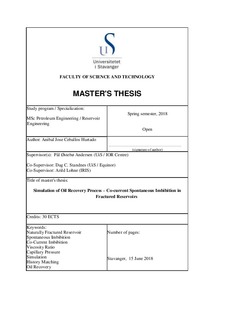| dc.contributor.advisor | Andersen, Pål | |
| dc.contributor.author | Ceballos, Anibal | |
| dc.date.accessioned | 2018-10-29T09:41:50Z | |
| dc.date.available | 2018-10-29T09:41:50Z | |
| dc.date.issued | 2018-06-14 | |
| dc.identifier.uri | http://hdl.handle.net/11250/2569895 | |
| dc.description | Master's thesis in Petroleum Engineering | nb_NO |
| dc.description.abstract | A large fraction of the world petroleum reserves is made up by Naturally Fractured Reservoirs (NFR) which are usually produced by waterflooding. The injected water flows primarily through the fracture network and cover the blocks; one of the main production mechanisms is “Spontaneous Imbibition” which is driven by Capillary Forces and can be either countercurrent or co-current displacement.
Several studies of spontaneous imbibition have been carried out to model the process of oil displacement from the matrix to the fracture. For co-current spontaneous imbibition case, there are some experiments that have been carried out by Meng et al. from China University of Petroleum. This type of experimental setup represent two ends open free spontaneous imbibition (TOEFSI) boundary condition where the inlet of the glass column is in contact with water, while the outlet is in contact with oil.
This thesis project will address the spontaneous imbibition phenomenon focused on simulation of co-current imbibition in fractured reservoirs. One-dimensional (1D) horizontal homogeneous model of spontaneous imbibition is proposed with initial and boundary conditions of the experimental setup by considering the domination of co-current flow takes place during displacement. For simplicity, the oil displacement in the model is only governed by capillary forces. By modelling this type of phenomenon from a core scale approach, it can be obtained an analytical model which clearly describes the flow processes that occurs in the oil recovery.
Furthermore, sensitivities analyses were made to have a better understanding of the dynamics of the imbibition process and the coherence of production profile between experimental and simulated results during History Matching. The main findings obtained were the imbibition rate and oil production varies according to the mobilities ratio; the co-current production was always more dominating than counter-current production along the imbibition process. The imbibition rate is proportional to the co-current oil production and inversely proportional to the counter-current oil production; as the oil viscosity increases, the front saturation decreases which leads to a lower saturation at breakthrough. The counter-current production obtained was higher compared to the experimental results and this lead to a reduction on the imbibition rate as well as the co-current oil production. For the Air and Kerosene experiments, the imbibition rates showed a decreasing trend and the mismatch between the curves was smaller compared to the WHOIL15 and WHOIL32 experiments which showed an increasing trend and a bigger mismatch among the simulated and the experimental results. | nb_NO |
| dc.language.iso | eng | nb_NO |
| dc.publisher | University of Stavanger, Norway | nb_NO |
| dc.relation.ispartofseries | Masteroppgave/UIS-TN-IEP/2018; | |
| dc.subject | petroleumsteknologi | nb_NO |
| dc.subject | petroleum technology | nb_NO |
| dc.subject | naturally fractured reservoir | nb_NO |
| dc.subject | spontaneous imbibition | nb_NO |
| dc.title | Simulation of Oil Recovery Process – Co-current Spontaneous Imbibition in Fractured Reservoirs | nb_NO |
| dc.type | Master thesis | nb_NO |
| dc.description.version | submittedVersion | nb_NO |
| dc.subject.nsi | VDP::Teknologi: 500::Berg‑ og petroleumsfag: 510::Petroleumsteknologi: 512 | nb_NO |
